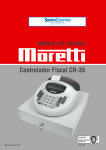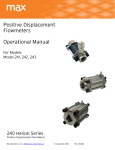Download Lincoln Electric Softweld, Ferroweld, Aluminweld Cast Iron and Aluminum Arc Welding Electrodes User's Manual
Transcript
WELDIRECTORY CAST IRON AND ALUMINUM ARC WELDING ELECTRODES Softweld ®, Ferroweld® and Aluminweld® CAST IRON / ALUMINUM ADVANTAGE LINCOLN SOFTWELD® 55 Ni (ENiFe-CI) A versatile, all-purpose electrode for repairing and reclaiming gray cast iron. It is recommended for repairing heavy sections and phosphorous bearing castings. Welds made with this electrode are strong and ductile. Multi-pass welds are typically machinable. Operational characteristics are excellent. ELECTRODE IDENTIFICATION AND OPERATING DATA Sizes and Current Ranges (Amps) Marking Printed on Electrode Polar- 3/32” Size 1/8” Size 5/32” Size Coating (2.5mm) (3.2mm) (4.0mm) ity Electrode Coating Color Ferroweld Black St DC(+); AC -- 80-120 --- Softweld 55 Ni Black NiFe-CI DC(+) AC 40-65 50-65 70-95 80-95 100-135 110-135 Softweld 99 Ni Black Ni-CI DC(+) AC 50-80 50-80 80-110 85-120 100-140 110-150 Aluminweld 43 White None DC(+) --- 85-135 110-165 ELECTRODE CONFORMANCES, APPROVALS & TYPICAL PROPERTIES SOFTWELD® 99 Ni (ENi-CI) A high nickel electrode specifically recommended for applications where machinability is important. Even single pass welds are machinable. It is recommended for surfacing applications and repairing small casting defects when the deposit will require machining. Electrode Conforms to Test Requirements of AWS Specifications Class Ferroweld A5.15 ESt Softweld 55 Ni A5.15 ENiFe-CI Softweld 99 Ni A5.15 ENi-CI Aluminweld 43 A5.3 E4043 FERROWELD® (ESt) A low cost steel electrode for repairing cast iron. It is recommended for repairing pits and small cracks in castings. The deposits are not machinable but may be finished by grinding. ALUMINWELD® 43 (E4043) An extruded electrode for both metallic arc and carbon arc welding aluminum plate. The dense high strength welds can be polished leaving practically no discoloration. The molten flux retards oxidation and dissolves excess aluminum oxide to produce high quality deposits. The serviceability of a product or structure utilizing this type of information is and must be the sole responsibility of the builder/user. Many variables beyond the control of The Lincoln Electric Company affect the results obtained in applying this type of information. These variables include, but are not limited to, welding procedure, plate chemistry and temperature, weldment design, fabrication methods and service requirements. GUIDELINES FOR WELDING CAST IRON ing after welding to restore the strength and ductility requirements to the part. Although they can be welded, the special procedures and heat treating required makes repair welding these materials expensive. The majority of cast iron parts are gray cast iron. These guidelines are limited to welding this material. Because of its hard and brittle structure, welding white cast iron is generally impractical. Malleable, nodular, and other heat treated types of cast iron usually require heat treat- How to Locate Cracks - A simple but effective way of locating surface cracks is to use commercial dye penetrant methods. As an alternate, you can swab the damaged area with a kerosene soaked rag to remove grease and dust. Immediately chalk over the area with common GUIDELINES FOR WELDING CAST IRON (CONT.) blackboard chalk. After a few minutes, even cracks not visible to the naked eye are evident because the kerosene from the cracks bleeds back through the chalk. Preparation for Welding - For weld soundness, the cracks must be properly prepared before welding. Drill a hole at the end of each crack to prevent it from extending further. Grind, chip, machine or saw the crack to create a bevel. Gas cutting or arc gouging can be used on castings that are preheated for welding. Be sure to get to the bottom of the crack. On sections more than 3/16” (4.8mm) thick, bevel the edges so the root of the joint is 1/8” (3.2mm) to 3/16” (4.8mm) wide. If the crack extends through the section, leave about a 1/8” (3.2mm) gap and 1/16” (1.6mm) land. 1/16” 1/8” Remove surface scale by grinding wherever welds are to be placed. Be sure the work is clean and dry. Preheating drives moisture and oil out of the casting. Types of Electrodes to Use - For machinable welds, use Softweld 99 Ni or Softweld 55 Ni. However, the fusion line between Softweld deposits and the cast iron may be too hard to machine unless the casting is preheated over 500°F. Ferroweld deposits are not machinable. Welding Techniques with Preheating - Although the welding of gray cast iron has been made to sound “mysterious”, it can be readily done if a few facts about the metal and how it is made are understood. Most of the difficulty is caused by the high carbon content in cast iron usually between 2% and 4% carbon. This fact, plus an understanding of how cast iron is made, indicates the heating-cooling cycles needed for successful welding. A gray iron casting is made by pouring molten iron into a mold. It is allowed to cool slowly. As it cools, the carbon in the metal becomes a flaky form of graphite. This graphite gives the iron its characteristic gray color and some of its properties. When it is welded, part of the gray iron is melted and an area adjacent to the weld is raised above a temperature called a critical temperature - about 1450°F. The mass of the casting around the weld tends to draw the heat from the weld area rapidly. If this cooling of the heat-affected zone and the weld is more rapid than it was when the casting was originally made, a highly brittle, crack-sensitive area forms. The best method to slow the cooling rate is to preheat the casting to prevent the iron from rapidly absorbing heat from the weld area. This requires a preheat temperature between 500° and 1200°F. Do not preheat over 1400°. Preheat temperature can easily be determined by using special heat indicating crayons. Preheat the entire casting slowly and uniformly. Do not attempt to preheat only the area to be welded. Always use low currents for minimum penetration and low ad-mixture. Weld with short 3” (76.2mm) to 5” (127mm) beads. Immediately after welding, peen each bead to relieve stresses. Be sure the preheat temperature is maintained until the entire welding job is completed. After welding, allow the casting to cool slowly to room temperature overnight just as it did when it was originally made. To do this, furnace cool or cover the casting with dry sand, powdered lime, or a fireproof blanket. This will produce a strong, ductile deposit and fusion zone which is relatively free of cracks. Welding Techniques without Preheat - Because of the size or other problems, preheating the casting is often impractical or impossible. In such cases, the cracks can still be repaired. Prepare the crack for welding with the same methods described previously. When heat is applied suddenly to glass, it cracks. In this way, cast iron resembles glass. Cast iron should never be welded cold. When the high preheat temperatures cannot be applied, heat the casting to about 100°F. Do not try to weld outdoors in cold weather. If the part being welded is an engine block or head, a uniform preheat can be obtained by running the engine, if possible, for a few minutes. Never heat the casting so hot that you cannot place your bare hand on it. Make very short beads - not over 1” (25.4mm) long. Immediately peen each bead while it is hot to relieve shrinkage stresses and retard cracking. While one bead is cooling, deposit others at scattered points throughout the joint. All weld craters must be filled. Whenever possible, this is done by ending a bead by blending its crater into the start of a previously deposited bead. All beads should be deposited in the same direction. Ends of adjacent parallel beads should not line up with each other. 4 6 2 3 5 1 Let each bead cool to the point where it can be touched with a bare hand before starting an adjacent bead. Sealing Cracks - Because of the nature of cast iron, tiny cracks tend to appear next to the weld even when GUIDELINES FOR WELDING CAST IRON (CONT.) ALUMINUM ARC WELDING ELECTRODES Hold the electrode almost perpendicular to the work at all times to obtain even melt-off of the flux. Point the arc directly into the joint so both edges are properly and uniformly heated. good procedures are followed. If the casting must be water tight, this can be a problem. However, leaking can usually be eliminated with some sort of sealing compound or they may rust shut very soon after being returned to service. PROCEDURES - USE ELECTRODE POSITIVE (DC+) For tacking, use currents about 20% above the maximum current listed in the recommended ranges. Use a short arc with a rotary motion. The Studding Method - One method used to repair major breaks in large castings is to drill and tap holes over the beveled surface area. Screw studs into the holes leaving 3/16” (4.8mm) to 1/4” (6.4mm) of the stud above the surface. Then, using the standard methods and electrodes described here, weld the studs in place and cover the entire surface of the break with weld deposit. Once a good weld deposit layer is made, the two sides of the crack can be welded together with more conventional methods. However, overheating the casting area must still be avoided. In cases of severe damage, use of mild steel plates sometimes produces good results. To do this, cut out the damaged area. Fit a piece of mild steel of the appropriate size in the damaged area and weld the steel to the cast iron. Use the welding methods and electrodes used to weld cast iron to cast iron. Hold a short arc with the coating almost touching the molten pool. Use the highest current possible without melting the edges back too far or burning through. The high melting rate of the aluminum electrode combined with the high conductivity of the aluminum plate chills the weld rapidly. Therefore, to keep the pool molten long enough to form well-shaped beads preheating to 600-700°F is often needed. Remove the last traces of slag with warm water and a wire brush or by soaking the weld in a 5% nitric acid or 10% warm sulfuric acid solution followed by a warm water rinse. WARNING: Be careful with these strong acid solutions. Wear safety glasses and avoid contact with skin or clothing. Avoid out-of-position welding. Strike the electrode by “scratching”. Strike the arc in the crater of the previous bead, then quickly move back along the weld for 1/2” (12.7mm) and proceed as usual. Be sure the crater is completely remelted. Aluminweld can also be used as a filler rod with a carbon arc torch. ¢¢QQQQ ¢¢¢¢ QQQQQ ¢¢¢ ¢Q¢Q ¢¢¢¢ QQQQ ¢¢¢¢¢ ¢QQQQQQ Q ¢ Q ¢ Q ¢ ¢Q¢QQQQ ¢¢¢ ¢Q¢Q Customer Assistance Policy The business of The Lincoln Electric Company is manufacturing and selling high quality welding equipment, consumables, and cutting equipment. Our challenge is to meet the needs of our customers and to exceed their expectations. On occasion, purchasers may ask Lincoln Electric for advice or information about their use of our products. We respond to our customers based on the best information in our possession at that time. Lincoln Electric is not in a position to warrant or guarantee such advice, and assumes no liability, with respect to such information or advice. We expressly disclaim any warranty of any kind, including any warranty of fitness for any customer’s particular purpose, with respect to such information or advice. As a matter of practical consideration, we also cannot assume any responsibility for updating or correcting any such information or advice once it has been given, nor does the provision of information or advice create, expand or alter any warranty with respect to the sale of our products. Lincoln Electric is a responsive manufacturer, but the selection and use of specific products sold by Lincoln Electric is solely within the control of, and remains the sole responsibility of the customer. Many variables beyond the control of Lincoln Electric affect the results obtained in applying these type of fabrication methods and service requirements. DISTRIBUTED BY: THE LINCOLN ELECTRIC COMPANY Local Sales and Service through Global Subsidiaries and Distributors Cleveland, Ohio 44117-1199 U.S.A TEL: 216.481.8100 FAX: 216.486.1751 WEB SITE: www.lincolnelectric.com Cast Iron/Non-Ferrous C8.10 6/99 web update 5/08




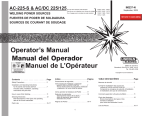
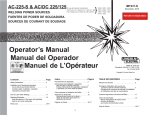

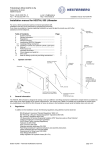
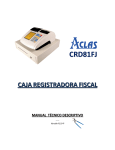
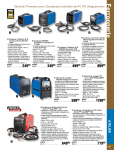
![[ TVS M ASCOT USER M ANUAL ] - TVS-E](http://vs1.manualzilla.com/store/data/005862685_1-4bbb7317613bf954ee62497b52c82516-150x150.png)
